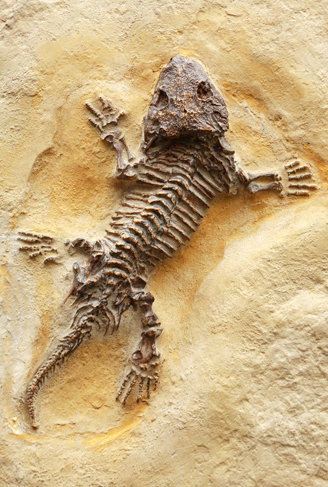History
The origin of reptiles is going back to the Carboniferous Period (359 - 299 million years ago). In this period, the different seas were overpopulated. In order to survive high predator pressure, vertebrates, in general, were forced to leave this habitat. The change of habitat started by laying their eggs on land. In order to live on land permanently, and thus leave the water environment, they had to evolve their breathing system. This essential development marked the birth of the species reptiles, birds and mammals.

Classification of the eras, in the Mesozoic reptiles had their peak
?
Image credits: alinabel/Shutterstock
The oldest tracks of a reptile dated from 312 million years ago. They belonged to the Hylonomus, a small lizard-like animal with a length of 20 - 30 cm (7.9 - 11.8”).
One of the biggest evolvements in the Carboniferous Period was the rise of the amniotes. This is thought to be a clade in the origin of reptiles, birds and mammals. Until then, animals were forced to return to water environments for their eggs. The evolution to the amniote egg, an egg with a hard shell, allowed the reptiles to reproduce on land.
Since they were the only vertebrate land animals at that time, there was no serious competition with other animals. There was little natural selection till the Carboniferous Rainforest Collapse on the Northern Hemisphere (Europe and America) 305 million years ago. There are several hypotheses about the reason behind this collapse, for example, a temperature drop. Whatever the exact reason, the consequence was a major change in the tree of fern-dominated ecosystems. While the life of marine animals was not influenced by this major change, large groups of land animals were affected. As a consequence, some land species changed their diet to become carnivorous.
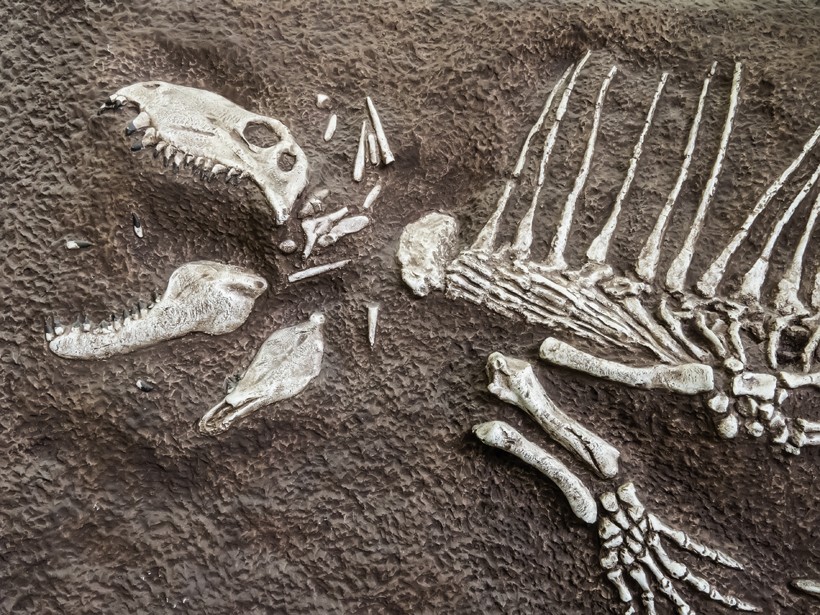
Pelycosaur. The crest on the back, which they used for temperature regulation, is clearly visible
?
Image credits: Ken Schulze/Shutterstock
In the late Carboniferous, the land animal life was dominated by the pelycosaurs and the cotylosaurs (captorhinidae). The pelycosaur was the first terrestrial megafauna (giant mammal) animal evolved from the synapsid amniotes. Spread over all continents, they maintained for almost 40 million years (late Carboniferous - Permian Period). Most of the pelycosaurs possessed a crest or membrane on their back at which heat could be absorbed or released. The cotylosaurs maintained until the end-Permian, early Triassic Period.
During the mid-Perm, the fauna changed as a consequence of a more dry climate. The pelycosaur evolved during this period to some kind of mammal-like reptile: the Therapsida (‘beast faces’; the name was given by T.H. Huxley for mammal-like reptiles, as a contrast to “lizard faces” [Saurapsida group]) group. The skeleton of this group of reptiles indicates that the Therapsida is the link to the current mammals.

Ichthyosaurs: the head of a dolphine but the taile of a shark
?
Image credits: Russell Shively/Shutterstock
The cotylosaur evolution resulted into two major groups, the archosaurs and the ichthyosaurs. The ichthyosaurs were carnivores with a tapered head, similar to the current dolphin head but with a shark tail. While the ichthyosaurs dominated the sea, the archosaurs prevail the land.
At the end of the Permian Period the greatest mass extinction, known as the Great Permian Extinction, took place. This resulted in an extinction of approximately 96% of the marine species and 70% of land vertebrate species!
The reason for this continental drift is unknown but could be a change in sea level, massive volcanism or a sudden release of methane from the sea underground.
Only smaller reptiles, which could regulate their temperature, survived these major changes. An explanation for their survival of these climatic changes could be their ability to hide in burrows or dormancy.
The archosaurs evolved to several groups including dinosaurs and pterosaurs. Both have commonalities with current reptiles. The major difference is that dinosaurs have a naked skin and lived on land while the pterosaurs were covered with feathers and dominated the airspace.
It was the dinosaurs that benefited from the major climate change 201 million years ago (Triassic-Jurassic extinction event). The sea level rose again (theory) and a tropical climate occurred in the north-east of Siberia, Alaska and the Alpines. The ectotherm or cold-blooded reptiles multiplied and evolved in various shapes. Only a few of the Therapsida group continued to exist and evolved to the current mammals.
This extinction with belonging changes in climate allowed the dinosaurs to play a dominant role in the Jurassic Period.
Dinosaurs were giants and sometimes larger than 20 meters. Several types weighted probably many thousands of kilograms. Their legs were facing forward, and contrary to current reptiles that have legs directed outwards.

Pterosaurs lived in airspace and had membranous wings, attached beween a long fourth finger and the body
?
Image credits: Dinoton/Shutterstock
Pterosaurs, also evolved from archosaurs, lived in airspace with membranous wings which were attached between a large fourth finger and their body. Birds as existing today are not evolved from pterosaurs, even though the pterosaurs were also flying, but from dinosaurs.
Both the dinosaurs as the pterosaurs were warm-blooded while the current reptiles are cold-blooded and have skin covered with scales or horned plates.
During the Mesozoic Era (252 to 66 million years ago) reptiles, dinosaurs and pterosaurs dominated wildlife. The Mesozoic Era is also known as ‘the Age of Reptiles’. Reptiles occurred in many species which were adapted to all possible environments. During the Late Cretaceous epoch (end-Mesozoic Era) the dinosaurs, pterosaurs and many reptiles disappeared. Till today, no proven explanation is available for this mass extinction.
The approximately over 7700 different species of reptiles that populate the earth today are unequally distributed across the earth. Only one species, the Squamata (scaled reptiles, snakes and lizards), is still expanding.
Skin
The relief on the skin, caused by the scales, is a major characteristic of reptiles. The watertight skin is, unlike most amphibians, dry, allowing reptiles to live in dry habitats.
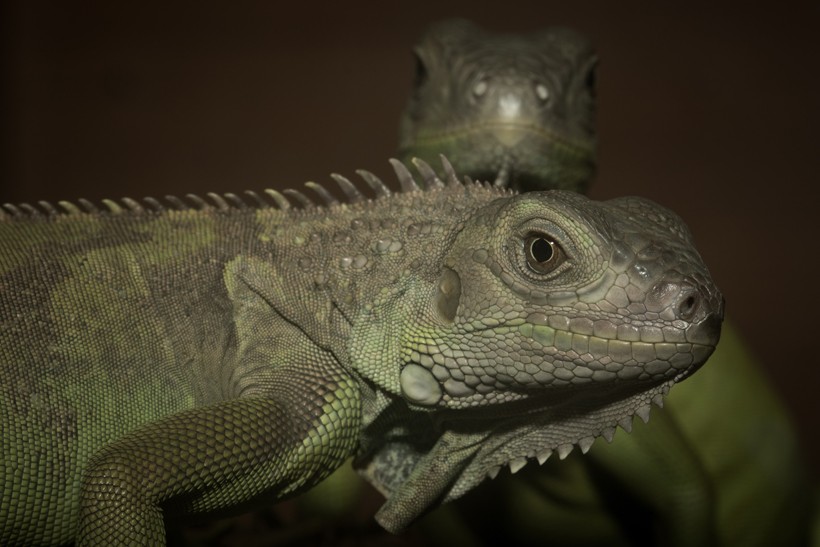
Relief of this green iguana clearly visible
?
Image credits: TTshutter/Shutterstock
The scales often cover the whole body of the reptile. Though there are reptiles which show areas without scales in order to facilitate easier movement. Turtles, for example, have an area without scales around their neck.
The scales are connected to a ‘sheet’ and thus aren’t detachable separately (like fish scales).
Scales appear like roof tiles (snakes) or like granular scales. They can be smooth, decorated with outgrowths, and sometimes like big plates (lizard heads).
Though the skin is relatively thin, it provides protection for internal organs and gives protecting cover against predators through the pigment it possesses.
This pigment, which causes the camouflage, consists of multiple layers. The top layer is replaced regularly.
Glands hardly occur in the skin of reptiles, though it contains lots of nerve endings allowing them to feel. More about the nerves can be read in senses
Molting
The preparation period before the molting lasts for snakes a couple of days and for lizards more than a week. The color fade away, the cornea becomes turbid and the animal stops eating. The molting starts with a laceration somewhere around the mouth. The reptile rubs its head against rough surfaces (stones, trunks) in order to get rid of the old skin faster. All snakes molt losing their skin in one piece while lizards lose their skin in multiple pieces. Turtles and crocodiles molt evenly. Due to the hard skin they possess, molting allows snakes and lizards to grow.

Horned Viper before (left) and after (right) molt
?
Image credits: both Matteo photos/Shutterstock, edited by aboutanimals
During the molt, tissue fluid penetrates between the old and new skin. The interaction between the two skins is hereby loosened, allowing the removal of the old skin.
The molt takes place under the influence of thyroid hormones, which concentration is affected by the environment (temperature, air humidity, and food supply).
The regularity of moltings depends per species. Young reptiles and larger snakes molt more frequently as their growth are limited more frequently by their skin.
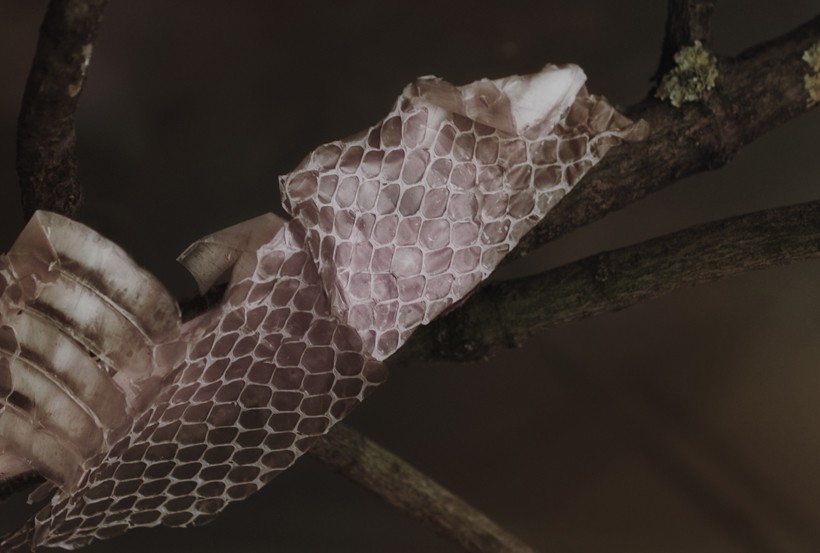
The old skin of a snake
?
Image credits: Korionov/Shutterstock
Skeletion & Brains
Reptiles are tetrapod vertebrates; they have four limbs or evolved from a four-limbed ancestor.
The vertebrae in the spinal column are connected through joints. All reptiles have 3 connecting points, except snakes which have 5 connecting points. This ensures both a mobile and solid backbone. Both spine and lumbar vertebrae carry ribs while the number of ribs depends per species. The shoulder and pelvic girdle are underdeveloped or absent. The different parts of the pelvic girdle are linked by cartilage on the ventral side.
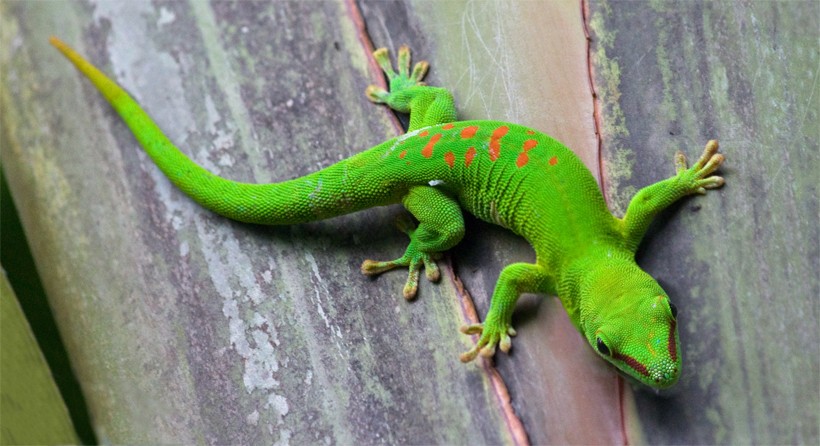
The feet of reptiles are turned outwards
?
Image credits: Fedor Selivanov/Shutterstock
The limbs of reptiles show similarities with other vertebrates. However, their feet are turned outward, which causes a swinging gait. Snakes and lizards without legs move through ‘crawling’; they make horizontal wave movements with their body by pressing themselves from the ground with their belly scales. A large number of vertebrae (sometimes over 400!) simplifies this method of locomotion.

Skeleton of a grass snake
?
Image credits: photowind/Shutterstock
The brains of reptiles, with the size of 1/10th of mammalian brains, are fogy and small in size. Reptile brains have significant overlap with amphibians though the cerebrum and cerebellum of reptiles are slightly larger.
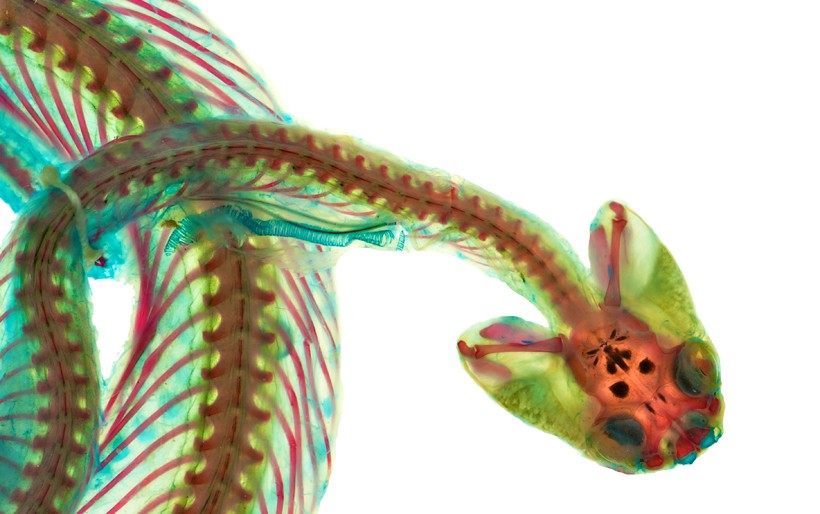
Brain of a rattlesnake clearly visible
?
Image credits: Pedro Bernardo/Shutterstock
They contain 12 cranial nerves, which arise indirectly from the brains. Two thickenings in the upper part of the brain constitute the well-developed visual cortex of the animals. Though the reptile brains are considered as less developed than mammals, it is observed that turtles show social behavior. Wood turtles are even better in learning how to navigate through mazes than white rats.
Senses
The existing nerve endings in the reptile skin allow them to feel. These endings appear both spread or in groups (spots) among reptiles skin. The auditory organ, which also serves as vestibular (balance) system, is better developed among reptiles that communicate with each other. The eardrum is located almost at the surface of the skin. The exception is the crocodile which does have narrow openings that lead to their inner ears, right behind their eyes. The eardrum is sometimes protected by a scaly cover. Due to their small inner ears, reptiles expand the range of audible frequencies through electrical tuning.
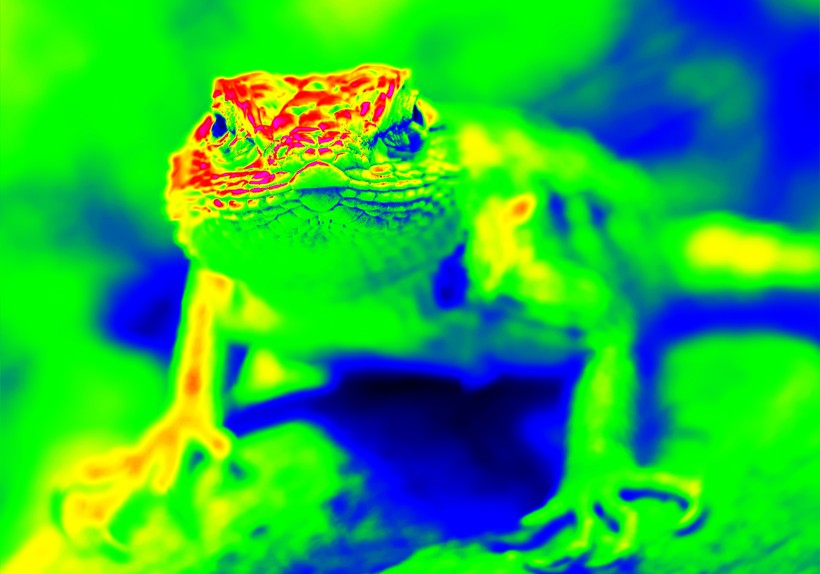
With the infrared heat sensitive senses, some reptiles can detect heat radiation
?
Image credits: honzik7/Shutterstock
Behind the scales around the mouth of many reptiles many little heat sensitive senses (infrared) are located, allowing reptiles to detect heat radiation (prey and predators). Pit vipers like the Eyelash Viper have an extremely sensitive fleece between their eye and nostril. With 1000 nerve endings per square millimeter they can notice a change in temperature of 0,026 degrees Celsius! This allows them to detect warm-blooded animals without visual contact.
The nostril serves both for breathing and smelling. Reptiles, except crocodiles and turtles, possess another smelling organ, called the Jacobson’s organ. This organ, which is like the olfactory room covered with olfactory epithelium, is connected by a channel with the palate (nearby the nasal passages). The Jacobson’s organ is due to its chemoreceptors very sensitive to chemical stimuli. The organ analyses molecules that make contact with the mucous membrane. For tuatara lizards, this contact occurs through breathing. By snakes and other lizards, this contact is achieved through transferring the molecules with their tongue. There are strong indications that Jacobson’s organ is also able to register differences in humidity, which facilitates the search for water.
The eyes, often located on both the sides of the head, are an important sensing organ for reptiles. They are generally adapted to daylight, can discriminate different colors and their visual depth is often more advanced than amphibians and most mammals.
The eyes are enrobed with a sclera, composed of cartilage. Focusing is performed by a change in the curvature of the lens. Furthermore, the pupil can be constricted or dilated.
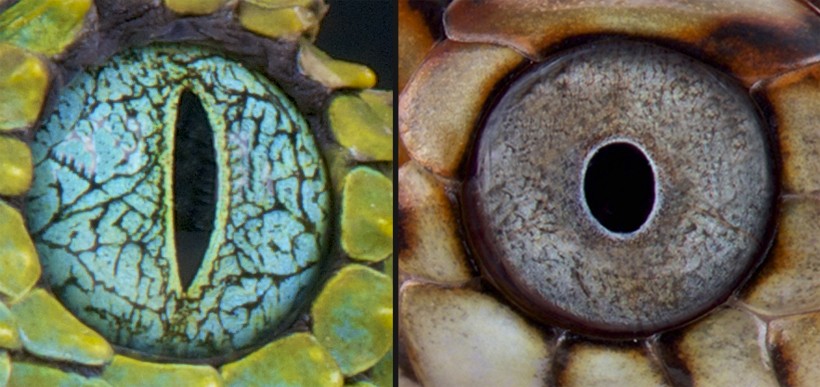
The pupil of day animals are round while nocturnal species have a vertical split-shaped pupil
?
Image credits: both reptiles4all/Shutterstock, edited by aboutanimals
Reptiles that are active during daytime show often round pupils. Nocturnal species on the other hand generally possess a vertical slit-shaped pupil. The eyes are protected with two eyelids.
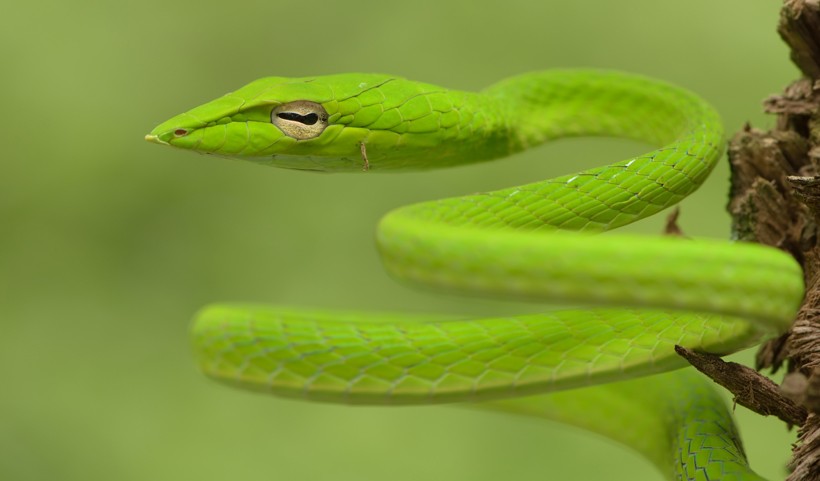
Though there are - of course - exceptions
?
Image credits: YapAhock/Shutterstock
Some species, however, possess like birds a third transparent eyelid: the nictitating membrane.
Lizards have a sharp view and can observe colors. Turtles, like the Aldabra Tortoise are also sensitive for infrared light. The view of snakes is less sharp. Just like crocodiles they presumably observe only shades of grey.
Lachrymal glands ensure the eye remains moist. A portion of the tear fluid passes through the tear ducts to the Jacobson’s organ, conducting the impurities.
Circulation of the blood & Respiration
Just like mammals and birds, reptiles have a double circulatory system. However, this is a simplified version as they have only one cardiac chamber (except crocodiles who have a four-chambered heart). The pulmonary circulation transports the blood to the lungs while the main circulation system transports the blood through the whole body.
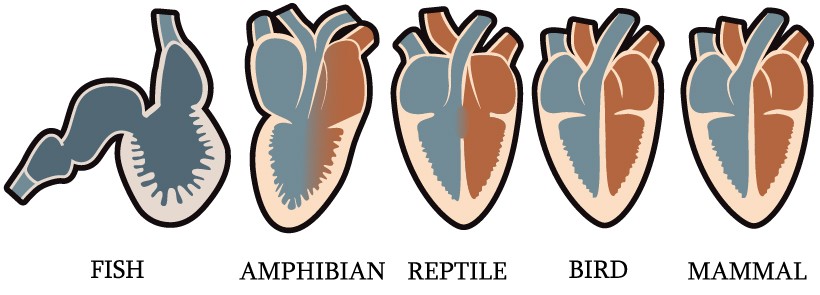
Heart anatomy comparison Fish, Amphibian, Reptile, Bird, Mammal
?
Image credits: Pawel Graczyk/Shutterstock
The heart of a reptile has two bosoms and one chamber. This cardiac chamber is partially divided into two parts, allowing oxygen-poor blood to mix with oxygen-rich blood. The degree of mixing varies among the species.
Reptiles are fully adapted to a life on land and breathe using lungs. Additionally, there are some species that have adapted cloaca to enlarge the respiratory area. Though the lungs remain essential, each main reptile group have different approaches for oxygen intake.
Their respiration system consists of a larynx, trachea and two lungs. Breathing is regulated by the mouth and chest.
Reptiles without legs contain a minor sized underdeveloped left lung while the right lung is extremely stretched. As a result, most Squamates are forced to hold their breath during long runs.
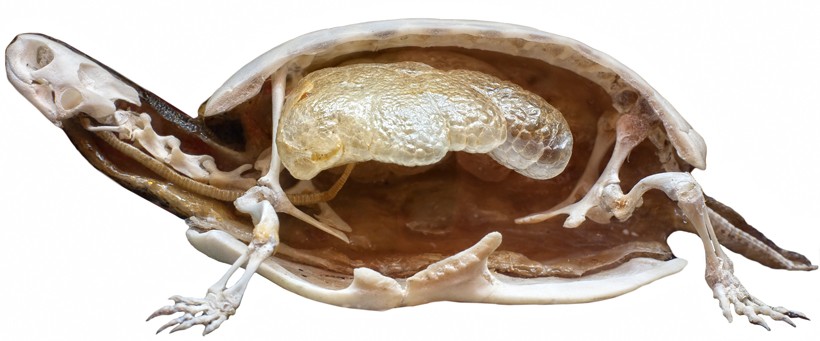
The hard armor of turtles makes is impossible to move their chest
?
Image credits: liubomir/Shutterstock
For a turtle, it is impossible to expand the chest because of the hard shield at its belly. They have special lung muscles that squeeze the air out of the lungs. Some turtle species stop or make smaller breaths while moving.
The respiration of crocodiles, despite the difference in muscle motion, is most similar to mammals.
Heat Regulation
Reptiles can’t regulate their own body temperature, hence, they’re ‘cold-blooded’. They need an ambient temperature within a specific upper and lower limit to survive.
The big benefit of being cold-blooded is the low metabolism in rest. Reptiles don't have to consume energy in order to heat the body. While having the same weight, a crocodile needs only 1/10 to 1/5 the food of a lion to maintain. A crocodile is able to live half a year without consumption.
Moreover, reptiles can live in “low-calorie” habitats while large warm-blooded mammals can’t.
"While the same weight, a crocodile needs only 1/10 to 1/5 the necessary food compared with a lion."
The preferred body temperature varies by type. For many lizards, this temperature is in between 24 and 35 degrees of Celcius, while in tropical zones the optimal temperature is often between 35 and 40 degrees of Celcius. Beside of these temperature ranges, it is to a certain extent possible to survive but their metabolism slowed down depending on the temperature. Reptiles heat themselves by incorporating heat from the environment (80% due to the sun, 20% due to earth warmth). Lizards above 4000 m high can exceed the environment temperature with 30 degrees of Celcius by just lying in the sun!
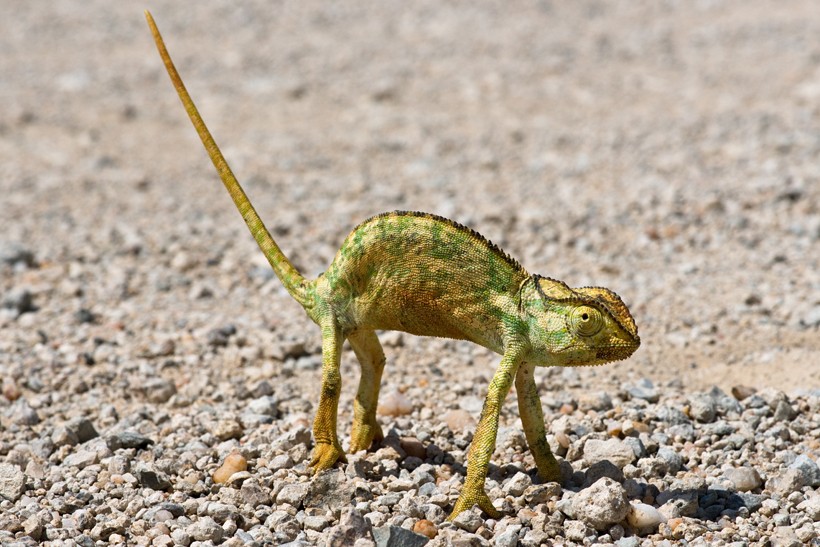
Namaqua chameleon cooling down by standing on its legs, provending warming up through the ground
?
Image credits: Isabella Pfenninger/Shutterstock
Once the optimal temperature is reached, the reptiles go back to the shadow. By getting on its legs, they avoid warmth uptake from the ground.
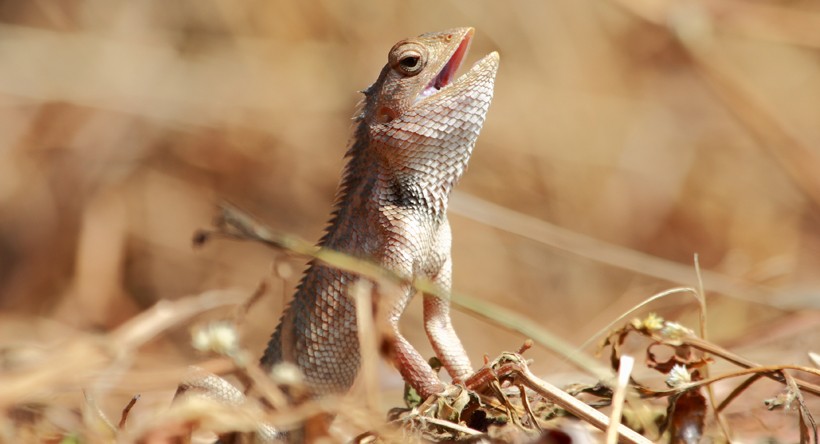
Oriental Garden Lizard cooling down through the tongue and mucous membrane
?
Image credits: Vishal shinde/Shutterstock
When the shadow is limited they open their mouth and accelerate breathing. As a result, heat is released by the tongue and mucous membranes. Alternatively, they also can search for caves and burrows to hide. Generally, reptiles expose themselves to solar heat in the morning, after experienced lower temperature during the night. Having reached optimal body temperature, the sun bath in normally followed by an active hunt, a resting period and eventually another hunt.
In moderate and cold temperature environment reptiles are only active during spring and summer. In fall and winter, the sun can’t heat them to optimal temperature and therefore making them unable to perform vital functions. They move back to a deep shelter for a brumate. This is a kind of hibernation, but with periods of awakeness, to be used for example to drink. In hot regions reptiles (except nocturnal animals) also keep a ‘hibernation’; in this case in summer, when the risk of overheating is a serious danger.
Reproduction
All sexual activities occur through the cloaca, an exit/entrance at the beginning of the tail. Except the tuatara, all reptiles have an internal fertilization. In general, reptiles have a copulatory organ. This organ is stored inside their body and extended during sexual activity. Snakes and lizards (Squamata) have a copulatory organ in the form of a pair of hemi-penises, however only one is used during sexual action. For crocodiles and turtles, the copulatory organ appears as a single median penis and is stored inside the cloaca.
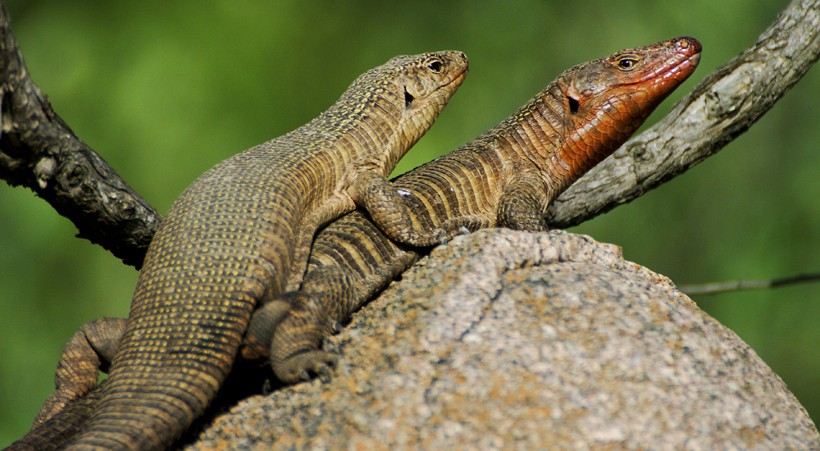
Giant plated lizards mating, Kruger national park, South Africa
?
Image credits: Sprocky/Shutterstock
The cloaca is often provided with spines or folds causing more grip. The shapes vary per species. The copulatory organ is missing by the tuatara. They simply press their cloacas together to transfer the sperm cells.
Often the sperm cells are stored by the female in the oviducts. After months or even years (up to 6 by a cat-eyed snake), they are still able to fertilize their eggs.
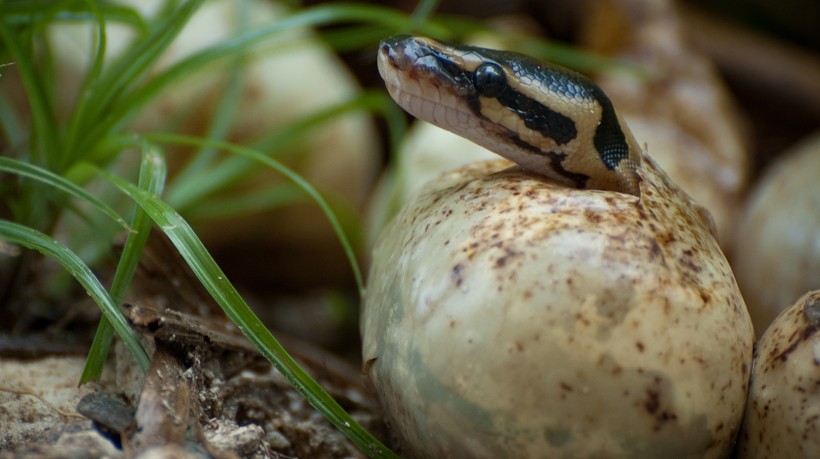
Python hatching, Everglades
?
Image credits: Heiko Kiera/Shutterstock
Most reptiles are oviparous but there are exceptions. The way of nesting differs a lot. Some lay their amniotic eggs in the open air while others bury them or lay the eggs in natural cavities like a cave or hollow tree. Mostly the females never return after the oviposit. The female Nile crocodile, however, guards the nest to discourage predators.
The amniotic eggshell protects the embryo and prevents it from dehydration while the shell allows gas exchange.
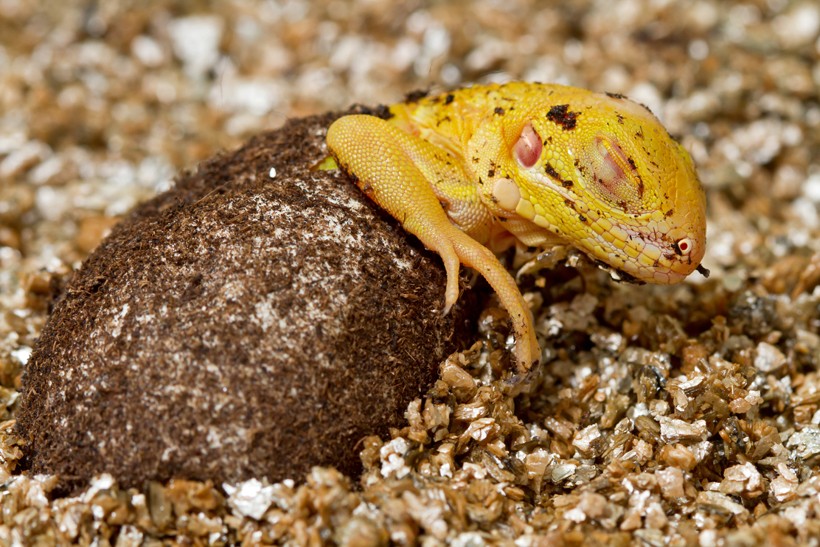
When males aren't available, some reptiles can reproduce themselves asexual.
?
Image credits: bluedogroom/Shutterstock
The percentage males and females are always even, with some exceptions. Some species have fewer males or they are even rare. In such situation parthenogenesis (asexual reproduction) appears in six lizard families and one snake family. With parthenogenesis, only females are born from the eggs. This method of reproduction is probably generated during the Cretaceous Period.
For almost all vertebrates, the gender is known after the mating. The gender generation by some reptiles, however, is achieved by temperature-dependent sex determination (TDSD). Temperature and humidity are hereby the factors that generate the gender.
High temperatures during the embryonic development cause only female turtles for example. This kind of gender generation occurs with turtles, crocodiles and some fish. By snakes and lizards, the gender is, in general, genetically encoded, without any influence of temperature. Though there are a view lizard and tuatara species that also use TDSD.
Environment & Classification
With the exception of Antarctica, reptiles appear on all continents. They have however a preference for warm habitats, showing small temperature variation. Some reptiles have adapted themselves extraordinary to their habitat; in the Himalayas, reptiles live up to 4300 meters high! The habitat has an influence on the number of clutches. In cold areas, the reptiles nest only once in the two-three years. The eggs, however, start already to develop in the body of the female.
At first, reptiles were classified in the same group as the amphibians. Josephus Nicolaus Laurenti was the first zoologist that used Reptilia for a separate division (18th century). In the beginning of the 19th century, it became clear that reptiles and amphibians are different animals in many aspects.

Crocodiles have more in common with birds than with other reptiles
?
Image credits: Albie Venter/Shutterstock
Many modern scientists prefer to replace Reptilia with the monophyletic Sauropsida, consisting of reptilia (reptiles) and aves (birds). The reason is that some reptiles have more in common with birds than with other reptiles (like the crocodile).
At this moment, reptiles occur in four orders:
- Testudines (turtles)
- Crocodylia (crocodiles)
- Rhynchocephalia (tuataras)
- Squamata (lizards and snakes)
Squamata contains 3 suborders; Lacertilia (lizards), Serpentes (snakes) and Amphisbaenia (worm lizards).
Turtles (Testudines, 250+ species) appear all over the world. Tuataras (Rhynchocephalia, 2 species), for 200 million years, live merely on a view islands around New Zealand (Oceania).
Crocodiles (Crocodylia, 22 species) only occur in tropical zones. Alligators can only be found in America (except one genus living in the Yangtze river in China, Asia).
Lizards (Lacertilia) are just like turtles found all over the world. They are divided into four major groups: the Cosmopolitans are common all over the world, New World lizards are common in America, Old World lizards can be found in Europe, Africa and Asia, and a remaining group of lizards with an interrupted spreading over the world.
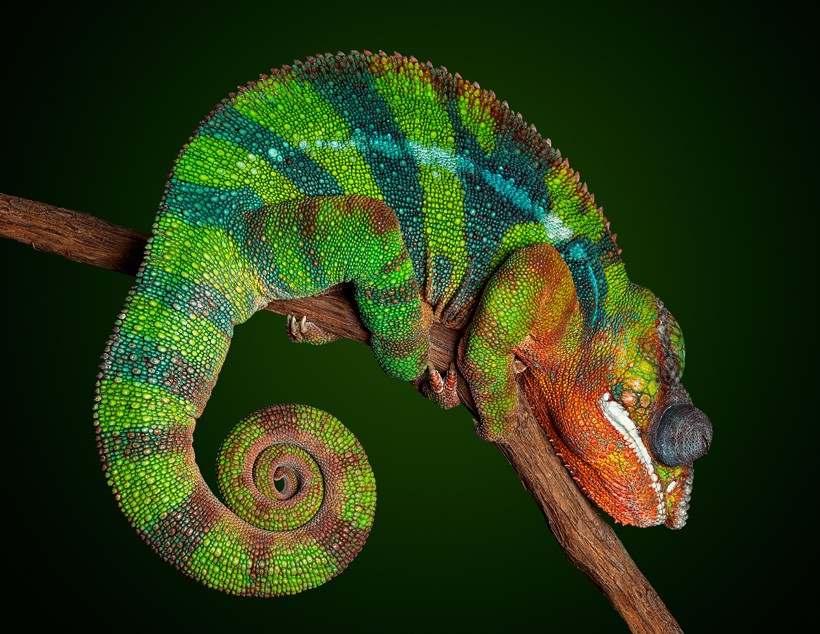
Chameleons are, with exception of a few species, unique to Madagascar.
?
Image credits: Cathy Keifer/Shutterstock
Chameleons, except for a view species located in India, are unique to Madagascar. Monitor lizards and agamids live in Ethiopia, Far East and Australia. The ordinary lizards live mostly in the moderate zones of Europe, Asia and Africa. Iguanas can be found predominantly in America (two species at Madagascar and one on the Fiji Islands).
The grass and coral snakes of the suborder snakes (Serpentes) live widespread over the world. Giant snakes only occur in tropical areas. Ordinary vipers can be found in the Old World while pit vipers can be found in America and Asia.
Diet
Most reptiles are carnivores though there are a view omnivores and herbivores. For many carnivorous reptiles, the primary food consists of other reptiles.
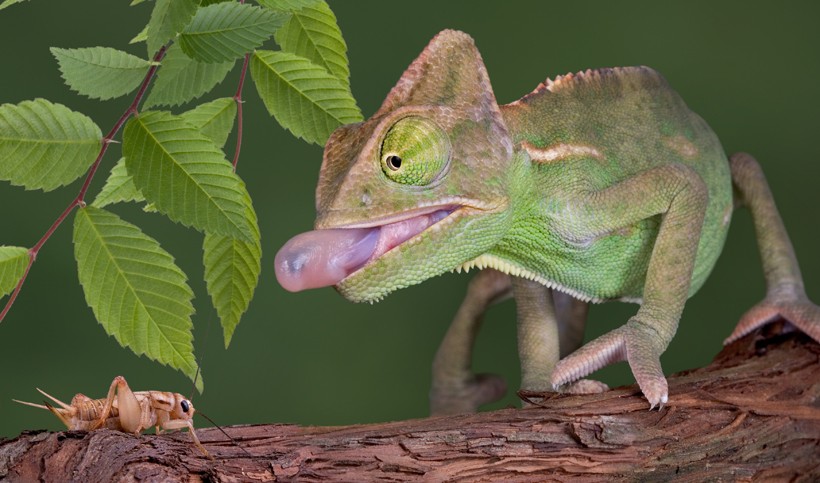
Baby veiled chameleon capturing a cricket
?
Image credits: Cathy Keifer/Shutterstock
The diet for lizards is mainly insects though they do not hesitate to eat other small animals.

The ballistic tongues of chameleons are 1.5 - 2 times the length of their body
?
Image credits: Cathy Keifer/Shutterstock
The blind-worm feeds on slugs and earthworms and the menu of the thorny dragon consists of ants (about 1000-1500 per meal!). On the Galapagos Islands appear the marine iguanas that live on seaweed.
Almost all snakes are carnivores too though there are some species (Dasypeltinae) that only eat bird eggs. They eat eggs up to 3 times the size of their head without breaking the egg-shell!
Some species in the rainforest of Central and South America have limited their diet merely to the eggs of tree frogs.
The senses used for the hunt depends per group. Lizards rely on their sight while snakes and turtles rely on their smell. Pit Vipers and Giant Snakes use their special heat sensitive fleece between their nostril and eye.
The hunting techniques also depend per group. Lizards, certain turtles and some crocodiles chase their prey but can also prepare an ambush.
Chameleons change their color and catch the prey with their tongue.
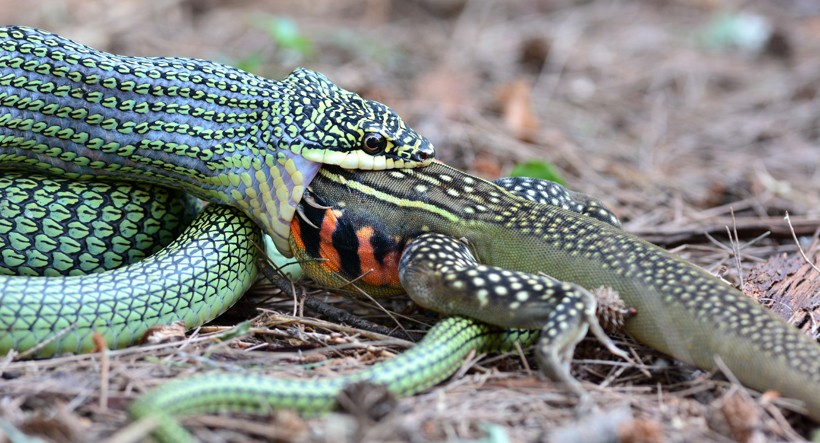
The golden tree snake eating a butterfly lizard whole
?
Image credits: Butterfly Hunter/Shutterstock
Most reptiles eat their prey as a whole. Though they have often lots of teeth, they are not meant for chewing. Snakes normally begin with the head, in this manner, the snake avoids damages to his mouth and or gullet through feathers, scales and/or claws. Turtles use their horned edge of their mouth to rip the meat first into pieces.
The time length of digestion depends on the temperature. The more it deviates from the ideal temperature, the longer it takes.
Cold-blooded reptiles have special enzymes that are capable of maintaining digestion efficiency over a larger range of temperature.
Through meat is relatively easy to digest, the digestion of a large meal can easily take months by crocodiles and large constrictors.
Only turtles are mainly herbivorous. Lacking teeth, they eat small rocks which help to pulverize the plants in the stomach.
Defensive Strategies
Many small reptiles are highly vulnerable to all kinds of carnivorous animals. Their number one defensive strategy is to avoid confrontation through camouflage. Without being seen, they observe the environment closely.
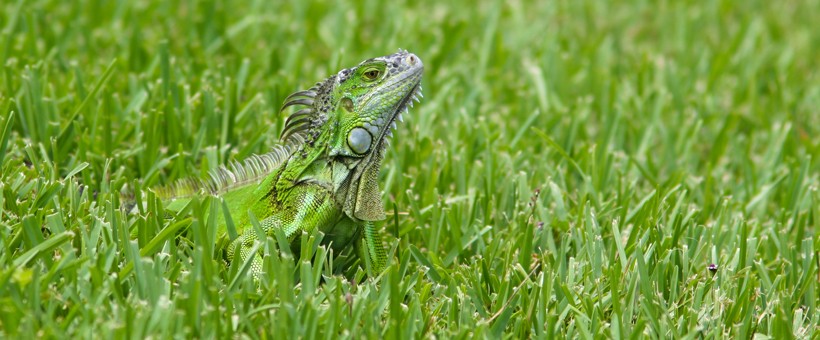
Green iguana perfectly camouflaged in the grass
?
Image credits: catlauren/Shutterstock
Most snakes and lizards living in vegetation or trees are green. Desert snakes are gray-yellow colored.
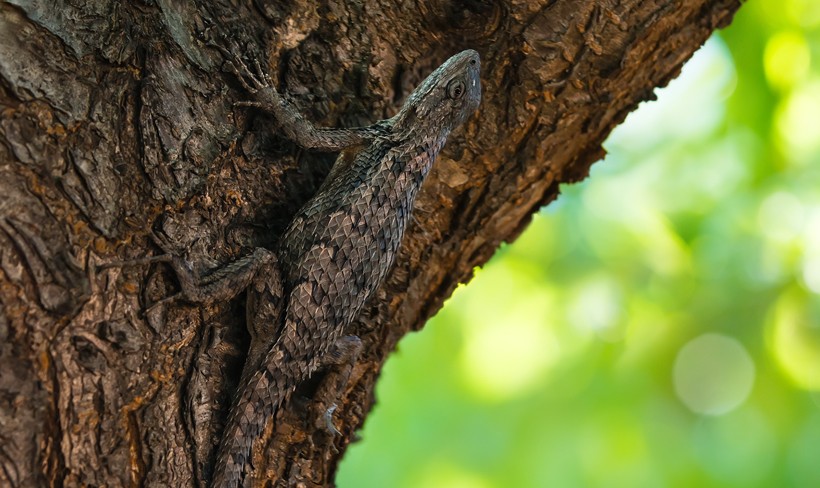
The texas spiny lizard has a brown camouflage which blends perfectly with a tree bark
?
Image credits: Leena Robinson/Shutterstock
Tree snakes are long and thin, and hard to distinct them from branches. With the use of cryptic coloring, they can hide perfectly in the natural environment.
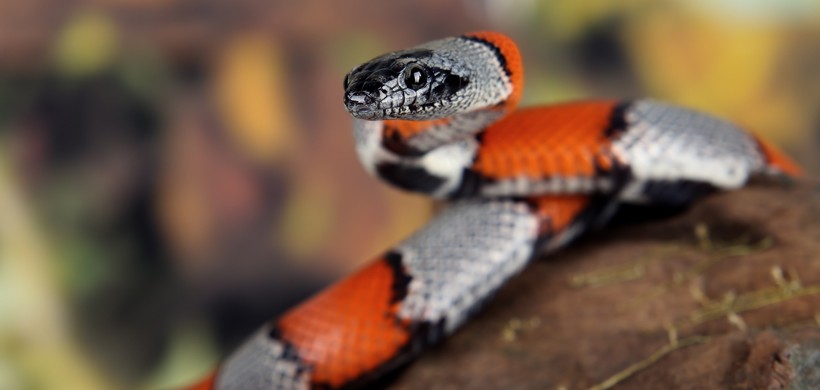
Instead of camouflage, coral snakes warns the predators that they're poisonous
?
Image credits: Enrique Ramos/Shutterstock
Instead of hiding with camouflage, coral snakes, Gila monsters and the beaded lizard warn potential predators for their toxicity with a high-contrast coloration.
Some harmless North American snakes imitate these bright colors, this phenomenon is called Batesian mimicry.
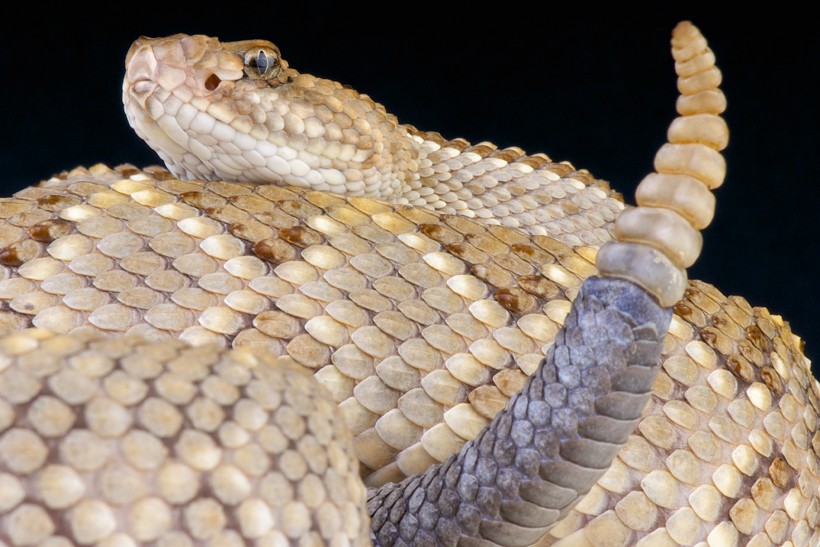
The aruba rattlesnake uses the rattle to ward off potential predators
?
Image credits: reptiles4all/Shutterstock
Rattlesnakes have hard hollow scales at the end of the tail. This allows them to produce a rattle sound to scare potential enemies.
This kind of sound is also generated by horned vipers and the saw-scaled viper by rubbing their scales against one another.
Reptiles have also some active defensive strategies like hissing or flying. Most of the lizards have also a very remarkable feature; when they are caught by a predator, they release their tale. The tail continues to wiggle and while the predator is diffused the lizard tries to escape. Concerning the leopard gecko, the tail continues to wiggle for up to 20 minutes!
As valid for many species, the tale has an intense color, encouraging potential predators to attack the tail first.
Usually, the tail regenerates afterwards. This process often takes less than a few weeks time. The regenerated tail, however, will never grow to the same length as the virgin one.
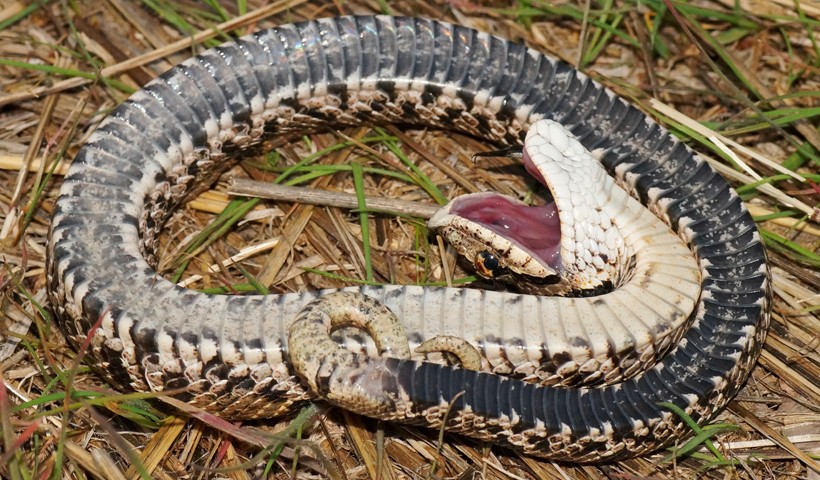
The Eastern Hognose Snake fakes his death when threatened
?
Image credits: Matt Jeppson/Shutterstock
There are also certain snakes and lizards that pretend to be dead; they lay on their back with a foam filled open mouth. Glands in the cloaca separate certain substances which smell like a decomposing body.
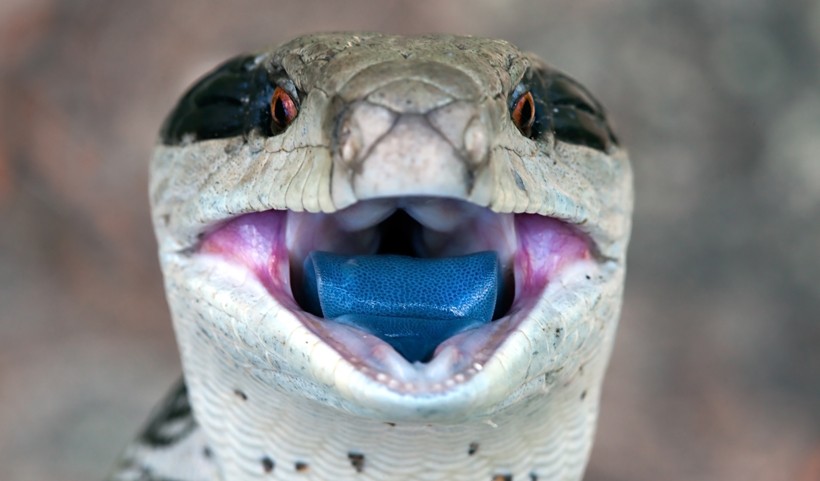
The blue-tongued skink scares its predators by showing the blue tongue
?
Image credits: Peter Waters/Shutterstock
Some lizards show bright colored body parts that are normally hidden under skin folds for a bigger and stronger look. The blue-tongued skink for example shows its blue tongue to ward off predators.
Turtles hide in their armor. Some turtle species can even close the armor with a hinged breastplate!
When defensive strategies appeared to be useless, reptiles can defend themselves physically by biting or by striking with the tale (crocodiles and some lizards).
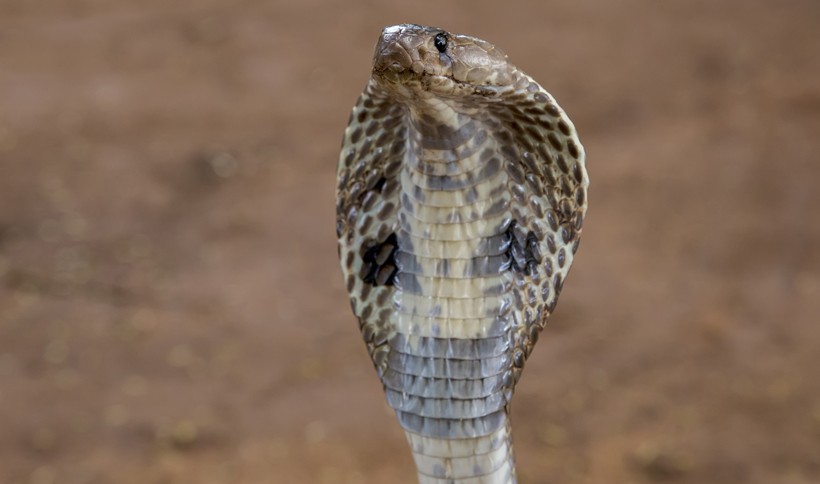
Cobras lift up their head and spread out the skin of their neck to look more dangerous
?
Image credits: Guillermo Pis Gonzalez/Shutterstock
